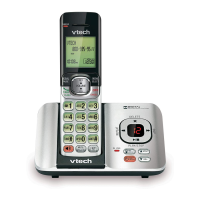71
Appendix
Appendix
About cordless telephones
Privacy: The same features that make a cordless telephone convenient create some limitations.
Telephone calls are transmitted between the telephone base and the cordless handset by radio waves,
so there is a possibility that the cordless telephone conversations could be intercepted by radio receiving
equipment within range of the cordless handset. For this reason, you should not think of cordless
telephone conversations as being as private as those on corded telephones.
Electrical power: The telephone base of this cordless telephone must be connected to a working
electrical outlet. The electrical outlet should not be controlled by a wall switch. Calls cannot be made
from the cordless handset if the telephone base is unplugged, switched off or if the electrical power
is interrupted.
Potential TV interference: Some cordless telephones operate at frequencies that may cause
interference to televisions and VCRs. To minimize or prevent such interference, do not place the
telephone base of the cordless telephone near or on top of a TV or VCR. If interference is experienced,
moving the cordless telephone farther away from the TV or VCR often reduces or eliminates
the interference.
Rechargeable batteries: Exercise care in handling batteries in order not to create a short circuit with
conducting material such as rings, bracelets, and keys. The battery or conductor may overheat and
cause harm. Observe proper polarity between the battery and the battery charger.
Nickel-metal hydride rechargeable batteries: Dispose of these batteries in a safe manner. Do not
burn or puncture the battery. Like other batteries of this type, if burned or punctured, they could release
caustic material which could cause injury.
The RBRC
®
seal
The RBRC
®
seal on the nickel-metal hydride battery indicates that VTech Communications, Inc. is voluntarily
participating in an industry program to collect and recycle these batteries at the end of their useful lives,
when taken out of service within the United States and Canada.
The RBRC
®
program provides a convenient alternative to placing used nickel-metal hydride batteries into
the trash or municipal waste, which may be illegal in your area.
VTech’s participation in RBRC
®
makes it easy for you to drop off the spent battery at local retailers
participating in the RBRC
®
program or at authorized VTech product service centers. Please call
1 (800) 8 BATTERY
TM
for information on Ni-MH battery recycling and disposal bans/restrictions in your area.
VTech’s involvement in this program is part of its commitment to protecting our environment and conserving
natural resources.
RBRC
®
is a registered trademark of Rechargeable Battery Recycling Corporation.
•
•
•
•
•

